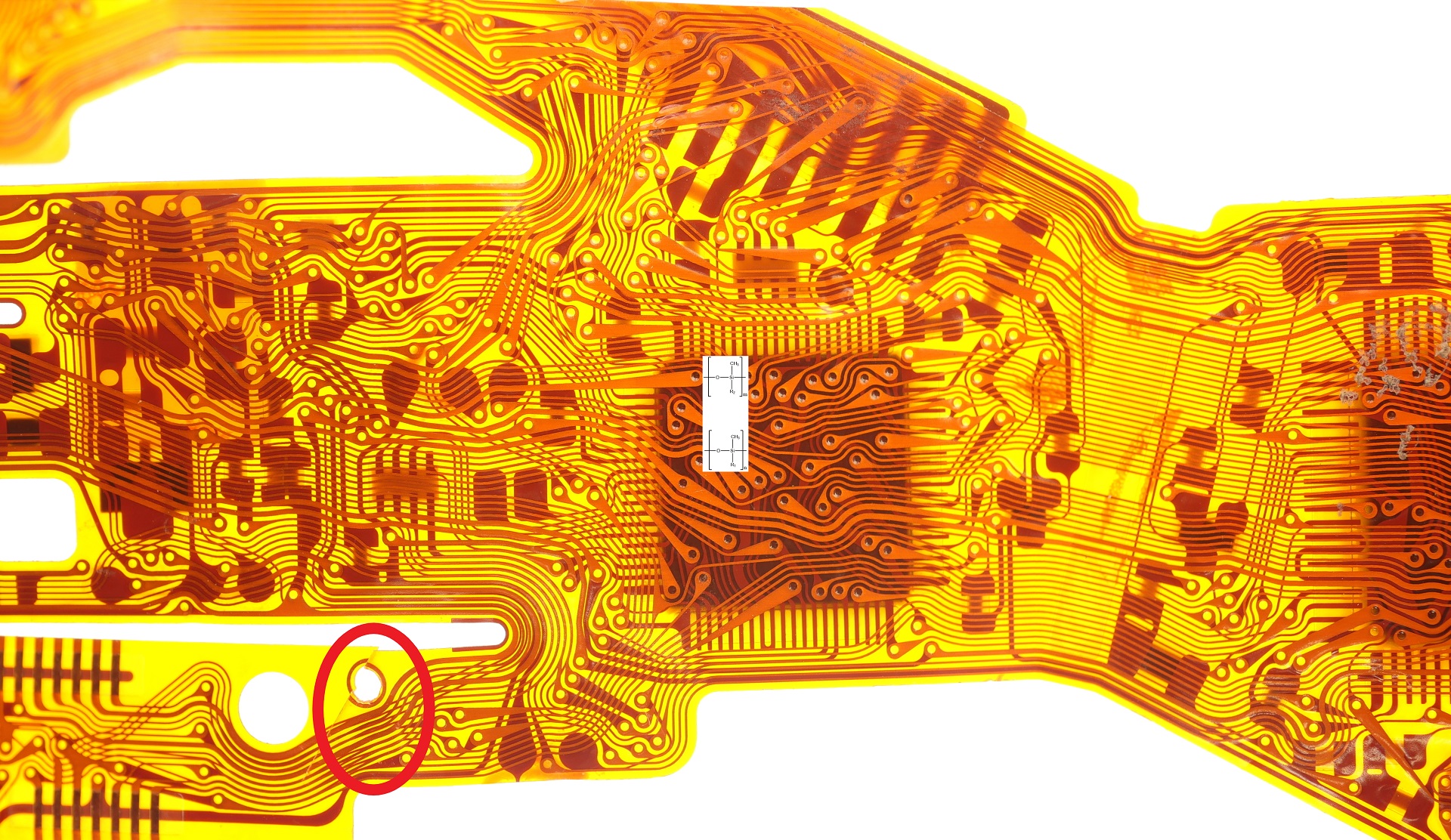

Epoxy resins are traditionally used in electronic applications as adhesives, potting systems and substrate materials. New possibilities are opened up by the inclusion of polysiloxane-epoxy copolymers in the epoxy resin formulations. With them, the resin systems can be controlled almost infinitely from hard to highly flexible materials.
BENEFITS AT A GLANCE:
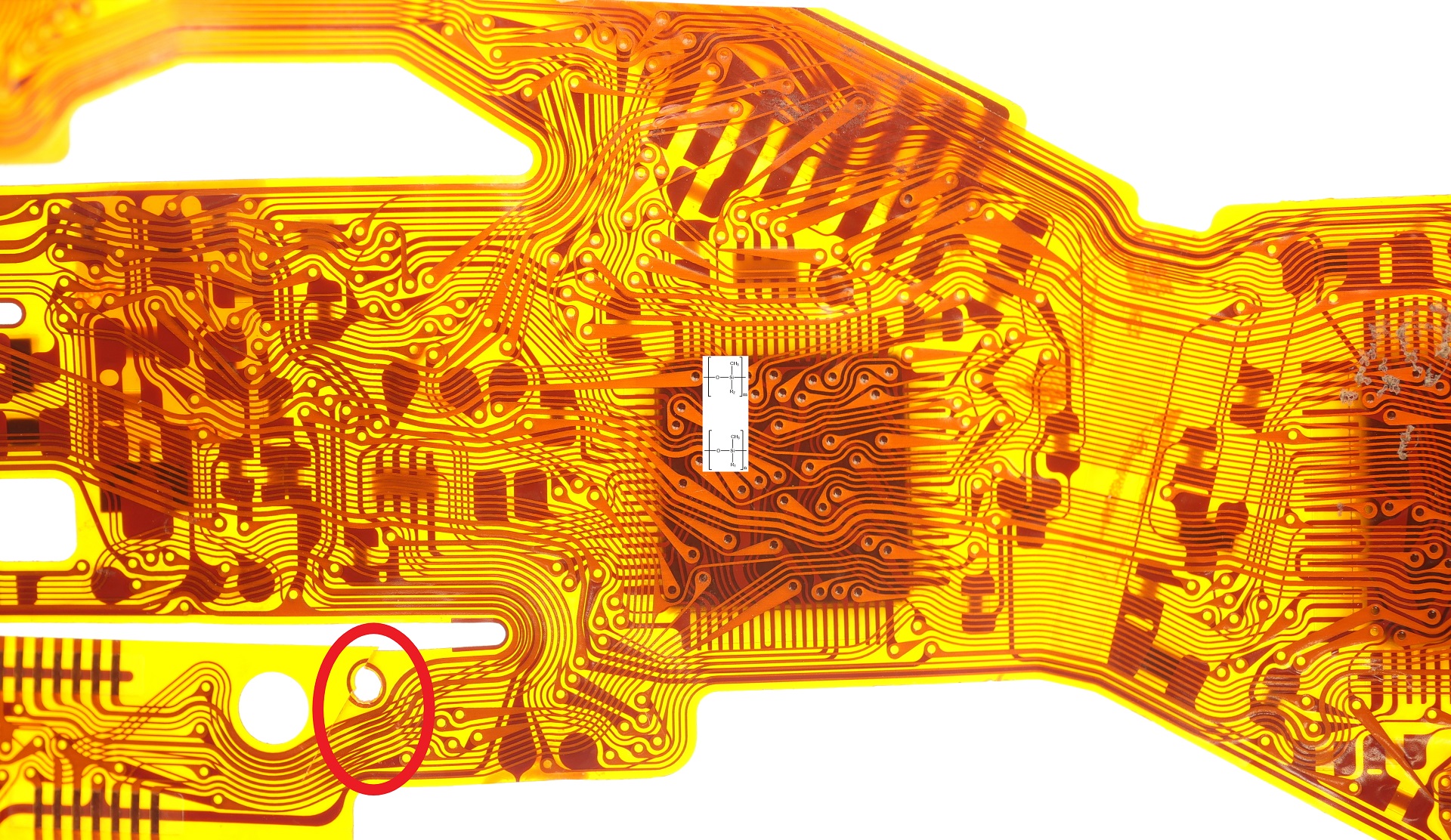
Figure 1 > Flexible printed circuit board (FCCL) with damage.
The trend towards increased use of electronic components and parts in daily life continues, despite a temporary chip short-age. The ongoing miniaturization of components to reduce size and weight or to enable completely new applications also poses ever new challenges for the materials used [1]. For many years, epoxy resins have traditionally been used in electronic applications such as adhesives, potting compounds and encapsulants or substrate materials due to their thermomechanical as well as their electrical properties. In 2020, the share of electronic applications of the total epoxy consumption in Europe was about 30 % [2]; in Asia, the share is even higher. If one considers the frequently safety-critical applications of electronic components, such as in aerospace, shipbuilding, energy management in electric vehicles, or simply in braking systems or airbags and sensors for vehicles, it becomes clear that extraordinarily high reliability is required of the materials used.
External influences such as frequent temperature changes, contact with service fluids or moisture can lead to a microcrack formation in the crosslinked epoxy resins; the causes and mechanisms of aging are largely well studied [3]. Constant mechanical stresses, especially in flexible printed circuit boards, so-called FCCLs, or new applications such as wearables, also require extremely high performance of the formulations (Figure 1). For many years, epoxy-functional polysiloxane core-shell particles have been used as impact modifiers, so-called tougheners, in epoxy resin formulations for electronics applications [3] [4]. However, since they are elastomer particles, the elongation of modified resin systems is not significantly changed. The property profile merely changes from hard and brittle to ductile and tough.
If mixtures of epoxy resins and such block copolymers are crosslinked with common curing agents, both interpenetrating networks and mixed networks are formed; with higher addition quantities up to crosslinking of the pure copolymer, the proportions of interpenetrating networks decrease. To the same extent, the elongation of the crosslinked resin systems increases. Understanding these structures is the subject of current, extensive research. Due to the high polysiloxane content in block copolymers, they improve both thermal and chemical resistances [5] and show excellent dielectric properties. As a result, they are significantly superior to conventional epoxy resins. Compatibility with common epoxy resins and all conventional curing systems for epoxies makes them exceptionally versatile.
External influences such as frequent temperature changes, contact with service fluids or moisture can lead to a microcrack formation in the crosslinked epoxy resins; the causes and mechanisms of aging are largely well studied [3]. Constant mechanical stresses, especially in flexible printed circuit boards, so-called FCCLs, or new applications such as wearables, also require extremely high performance of the formulations (Figure 1). For many years, epoxy-functional polysiloxane core-shell particles have been used as impact modifiers, so-called tougheners, in epoxy resin formulations for electronics applications [3] [4]. However, since they are elastomer particles, the elongation of modified resin systems is not significantly changed. The property profile merely changes from hard and brittle to ductile and tough.
This contrasts with polysiloxane-epoxy copolymers, a newly rediscovered class of raw materials. They can be used in electronic adhesives as well as in potting compounds, for example for sensors, or in carrier materials for flexible printed circuit boards. Due to their molecular structure, they can make conventional epoxy resin systems more flexible. Via the amount added, the formulation properties can be controlled almost continuously from hard to highly flexible materials (Figure 2). In case polysiloxanes or their epoxyfunctionalized derivatives are mixed with epoxy resins, phase separation occurs relatively quick due to incompatibility. This is largely independent of the molecular weight of the polysiloxanes and of the epoxy resins used. Block co-polymers with molecular segments of polysiloxanes and epoxides, on the other hand, are very compatible with epoxy resins. This is particularly true of the latest generation of these materials. Virtually any mixing ratio is now possible. Figure 3 shows schematically the structure of such a block copolymer. Long, flexible polysiloxane segments alternate with short, hard segments. Terminally, the molecules are epoxy-functional.
If mixtures of epoxy resins and such block copolymers are crosslinked with common curing agents, both interpenetrating networks and mixed networks are formed; with higher addition quantities up to crosslinking of the pure copolymer, the proportions of interpenetrating networks decrease. To the same extent, the elongation of the crosslinked resin systems increases. Understanding these structures is the subject of current, extensive research. Due to the high polysiloxane content in block copolymers, they improve both thermal and chemical resistances [5] and show excellent dielectric properties. As a result, they are significantly superior to conventional epoxy resins. Compatibility with common epoxy resins and all conventional curing systems for epoxies makes them exceptionally versatile.
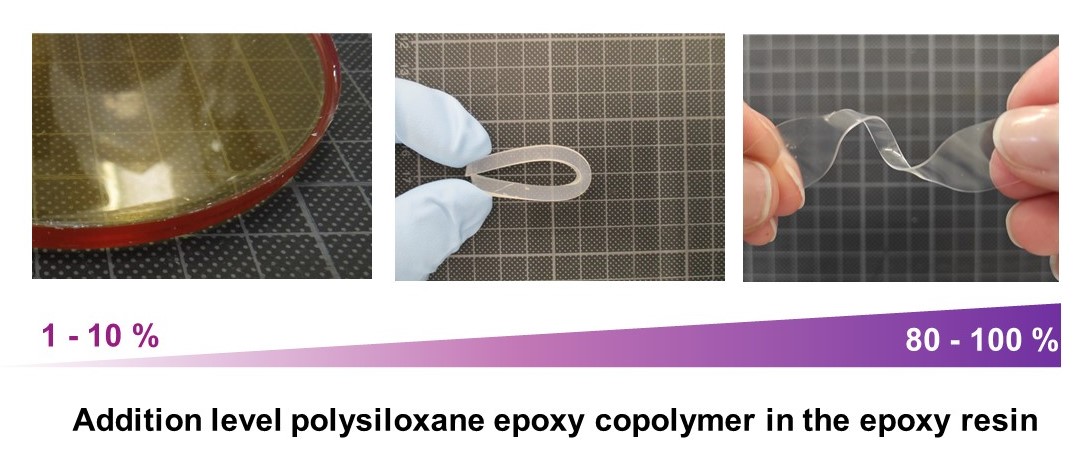
Figure 2 > Control of material properties via the proportion of copolymer in the epoxy resin.
Excellent adhesion to various substrates
When considering the use of polysiloxane- epoxy copolymers as adhesive raw materials for electronics applications, it is not only the higher flexibility and improved durability and media resistance of a bond, but also the improvement in adhesion to a wide range of substrates. For example, the tensile shear strength of an aluminum bond can be increased from 8.8 MPa to 10 MPa or 13 MPa where 9, 20 or 100, respectively, of the epoxy resin are replaced by the copolymer. This is accompanied by a significant increase in the flexibility of the bond.Adhesion to copper is particularly important in electronics applications. A thin layer of a blend of the pure copolymer with an amine curing agent was applied to a copper-coated FR4 base material and subjected to a cross-cut test. The performance was rated very good with GT 0-1 (Figure 4). A significant adhesion improvement was also found on other metallic and non-metallic substrates compared to unmodified epoxy resins.
This property is of great interest not only for adhesives, but also for potting compounds, since significantly better mechanical properties can be achieved, especially in highly filled systems.
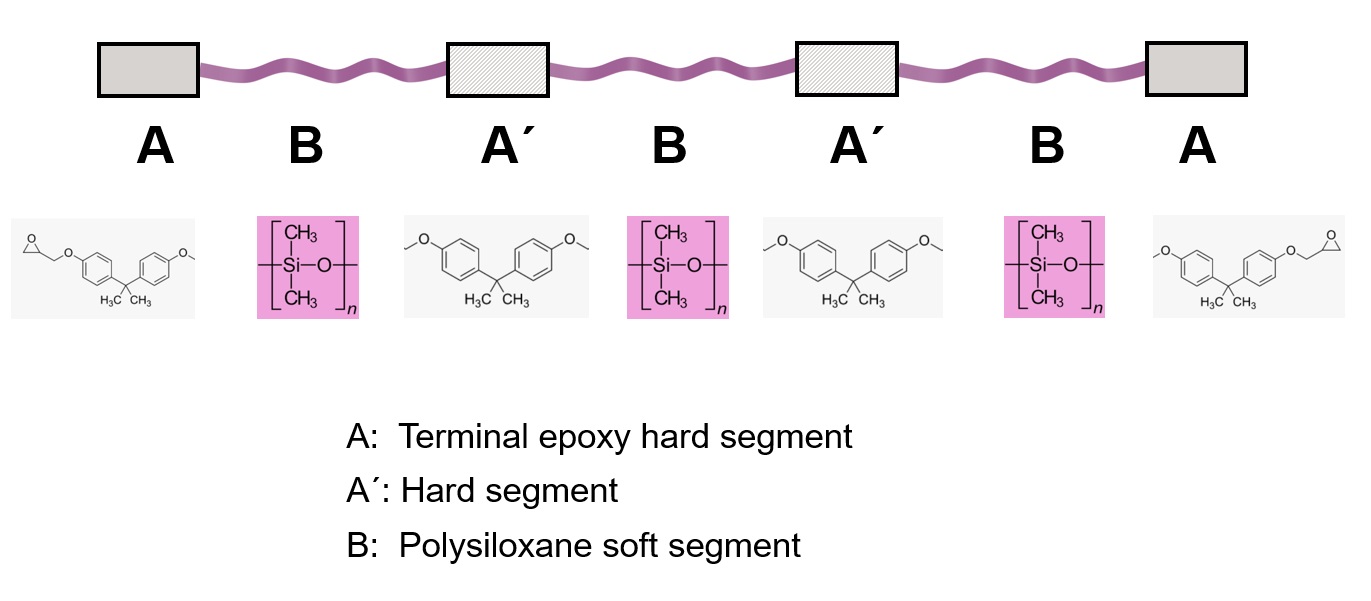
Figure 3 > Schematic structure of polysiloxane-epoxy block copolymers.
| Materials and Tests | |
|---|---|
| Resin: | standard DGEBA (Epikote 828, Westlake Epoxy) polysiloxan epoxy copolymer (Albiflex 297, Evonik Operations) |
| Hardeners: | formulated amine hardener (Ancamine 2167, Evonik Operations) accelerated anhydride hardener (Albidur HE 600, Evonik Operations) |
| Substrates: | aluminum alloy 2017 A AlCuMg1 PCB base material, FR 4 copper-cladded |
| Lap shear strength: | DIN EN 1465 |
| Tensile strength S2: | DIN 53504 |
| Cross cut test: | DIN EN ISO 2409 |
| 3-point bending test: | ISO 178:2019-04 |
| DMA: | ISO 6721-11 |
| TMA: | ISO 11359-2 |
| 85/85 Ageing: | DIN EN IST 9142 |
Extremely high reliability
The most common failure of electronic components, from printed circuit boards to component encapsulation and bonding, is caused by the formation of cracks in the polymers used, especially epoxy resins [6]. This is caused by mechanical, thermal or chemical stress and, of course, especially when several stresses are applied simultaneously over a long period of time.In anhydride-cured potting compounds, such as those used in sensor potting, the loss of strength during thermal aging is typically very high. Oxidative embrittlement reduces the flexural strength from 145 MPa by 57 % to only 63 MPa after storage at 180 °C for four weeks. If 10 % of the DGEBA standard resin is replaced by a polysiloxane-epoxy copolymer, the initial flexural strength of 138 MPa is somewhat lower; however, it is not reduced by heat aging. The dimensional stability of such a potting compound after heat aging is also significantly better; the coefficient of thermal expansion is hardly changed [5].
This results in a much higher reliability of such a system especially under very demanding service conditions. The same applies to the exposure of cured epoxy resin systems to aggressive media, oils or service fluids in aerospace applications [5].
Table 1 shows the very slight changes in the mechanical properties of a pure, amine-cured polysiloxane-epoxy copolymer due to hygrothermal aging. In the so-called 85/85 test, the cured polymer is stored for an extended period of time at 85 % relative humidity and 85 °C.
| Formulation (parts per weight) | ||||
|---|---|---|---|---|
| Albiflex 297 | 100 | |||
| Ancamine 2167 | 7,3 | |||
| Properties | Start | 250h @85/85 | 500h @85/85 | 1000h @85/85 |
| Tensile strength [σM/MPa] | 13 | 13 | 13 | 11 |
| Tensile modulus [Et/MPa] | 10 | 7 | 6 | 7 |
| Elongation [εM/%] | 108 | 134 | 145 | 128 |
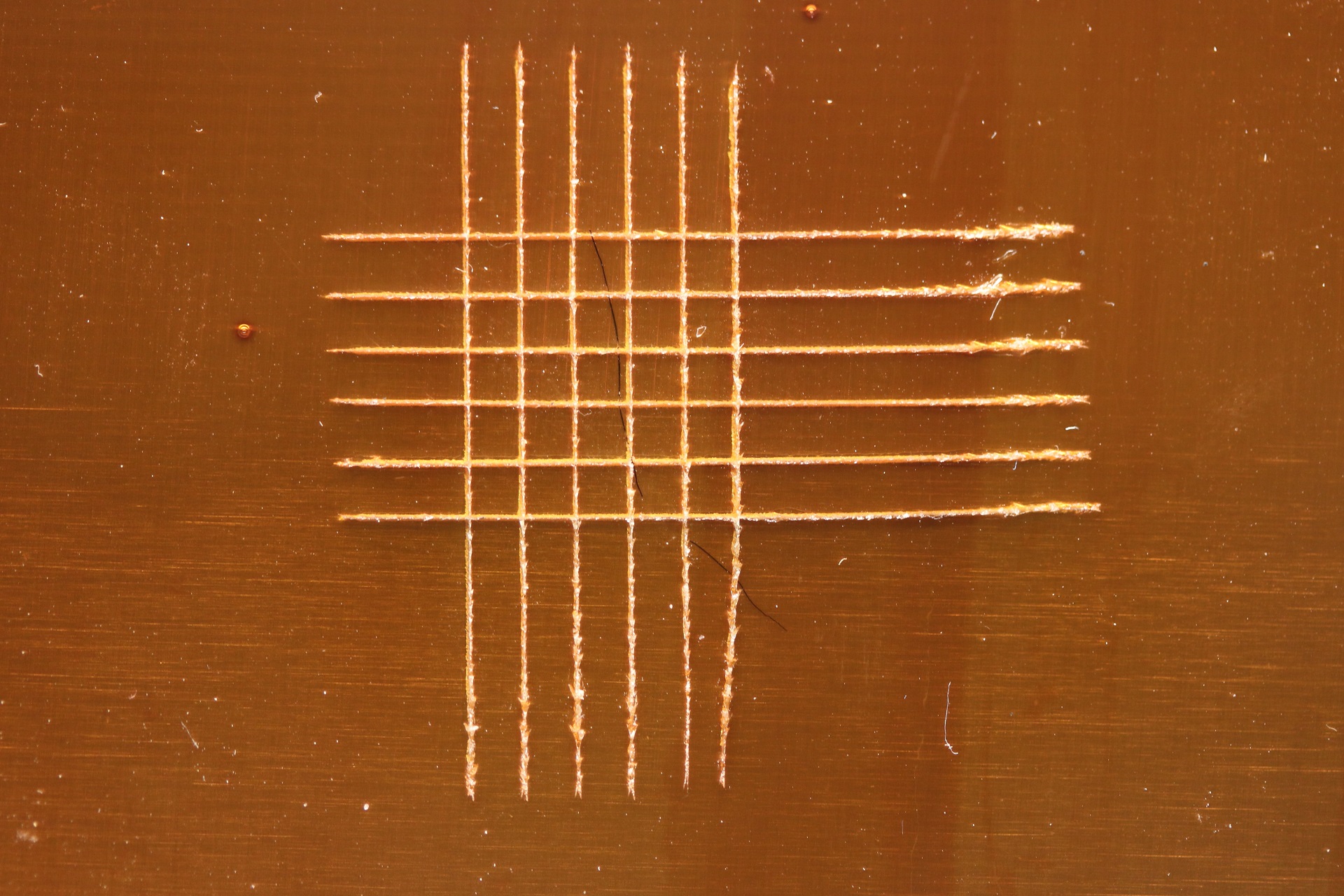
Figure 4 > Erichsen cross-cut test of an amine-cured silicone-epoxy copolymer on copper-cladded FR4 base material.
Summary and outlook
Polysiloxane-epoxy copolymers open up completely new perspectives for the formulation of epoxy resins for electronics applications: Due to the significantly improved mechanical, chemical and thermal resistances, much more reliable resin systems can be formulated that permanently withstand even the toughest operating conditions, for example, in fatigue-free adhesives, in potting or encapsulation systems, or as a substrate material for flexible printed circuit boards. Due to the possibility of continuously adjusting the flexibility, the desired property profile can be easily controlled by the amount of copolymer added to the epoxy resin. The strong electrical, thermal and chemical properties of polysiloxanes are elegantly combined here with the very good mechanical properties of epoxy resins.Possible synergies with other resin modifications such as nanoparticles are the subject of current research. In parallel, recycled siloxane raw materials are being tested for their suitability.
Going forward, epoxy resins largely derived from recycled wind turbine rotor blades will also be available as sustainable raw materials for polysiloxane-epoxy copolymers.
Going forward, epoxy resins largely derived from recycled wind turbine rotor blades will also be available as sustainable raw materials for polysiloxane-epoxy copolymers.
References
[1] Iwai, H.: “Impact of Micro-/Nano-Electronics, Miniaturization Limit, and Technology Development for the Next 10 Years and After”, ECS Transactions, Volume 102, Number 4, 81 (2021)[2] „Market Research Report Epoxy Resins”, Polaris Market Research, New York, USA (2020)
[3] Sprenger, S., Funck, A., Balthasar, J., Lubenow, T.: „Improving thermal and chemical stabilities of electronic epoxies using polysiloxane copolymers part I: core-shell particles“; Current Trends in Polymer Science 21, 1-16 (2021)
[4] Chen, J., Kinloch, A.J., Sprenger, S., Taylor, A.C.: "The mechanical properties and toughening mechanisms of an epoxy polymer modified with polysiloxane-based core-shell particles”; Polymer 54, pages 4276 – 4289 (2013)
[5] Sprenger, S., Funck, A., Balthasar, J., Lubenow, T.: „Improving thermal and chemical stabilities of electronic epoxies using polysiloxane copolymers part II: block copolymers“; IEEE Xplore 27, (2021)
[6] Teverovsky, A.: “Cracking problems in lowvoltage chip ceramic capacitors”, ASRC Federal Space and Defense. Online: https://nepp.nasa.gov/pages/pubs.cfm, 2018

